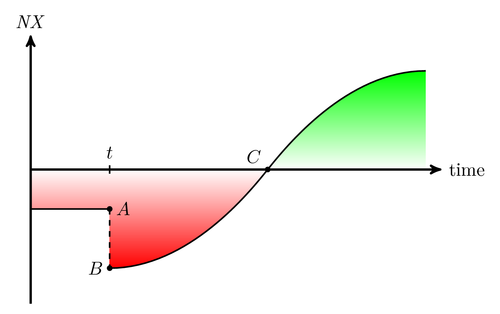An illustration of a countrys trade balance following a devaluation. The shape of the curve is known as a J-curve.

Edit and compile if you like:
% J-Curve
% Author: Rasmus Pank Roulund
\documentclass{minimal}
\usepackage{tikz}
\usetikzlibrary{calc,arrows}
\begin{document}
\begin{tikzpicture}[
%We set the scale and define some styles
scale=1.5,
axis/.style={very thick, ->, >=stealth'},
important line/.style={thick},
dashed line/.style={dashed, thick},
every node/.style={color=black,}
]
% Important coordinates are defined
\coordinate (beg_1) at (0,-.5);
\coordinate (beg_2) at ($(beg_1)+(1,0)$);
\coordinate (dev_1) at ($(beg_2)+(0,-.75)$);
\coordinate (xint) at (3,0);
\coordinate (end) at (5,1.25);
%We make some nice shading to annotate different parts of the curve
% Everything for x<0
\begin{scope}
\shade[top color=white, bottom color=red]
($(beg_2)+(0,.5)$) parabola bend (dev_1) (xint)
(0,0) rectangle (beg_2);
\end{scope}
% Everything for x>0
\begin{scope}
\shade[bottom color=white, top color=green]
(xint) parabola bend (end) ($(end)+(0,-1.25)$);
\end{scope}
% axis
\draw[axis] (0,0) -- (5.2,0) node(xline)[right] {time};
\draw[axis] (0,-1.7) -- (0,1.7) node(yline)[above] {$\mathit{NX}$};
% J curve is drawn
\draw[important line]
(beg_1) -- (beg_2)
(dev_1) parabola (xint)
(xint) parabola[bend at end] (end);
% coordinates are added
\fill[black] (beg_2) circle (1pt) node[right] {$A$};
\fill[black] (dev_1) circle (1pt) node[left] {$B$};
\fill[black] (xint) circle (1pt) node[above left] {$C$};
% The time of the devaluation is added
\draw[dashed line] (beg_2) -- (dev_1);
\draw[thick] (1,-1.5pt) -- (1,1.5pt) node[above] {$t$};
\end{tikzpicture}
\end{document}
Click to download: j-curve.tex • j-curve.pdf
Open in Overleaf: j-curve.tex

